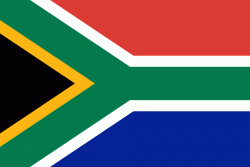Hessequa Local Municipality (Hessequa)
Hessequa Local Municipality (Hessequa Munisipaliteit, before 24 June 2005 the Langeberg Local Municipality) is a municipality located in the Western Cape Province of South Africa. It is flanked by the lower Breede River to the west and the Gourits River to the east. the population was 52,642. Its municipality code is WC042. The name Hessequa, meaning "people of the trees", refers to the tribe of indigenous Khoikhoi people.
The municipality covers an area of 5733 km2 between the Langeberg mountains and the Indian Ocean, stretching from the Breede River in the west to the Gourits River in the east. It abuts on the Swellendam Municipality to the west, the Kannaland Municipality to the north, the Oudtshoorn Municipality to the northeast, and the Mossel Bay Municipality to the east.
According to the 2011 census the municipality has a population of 52,642 people in 15,873 households. Of this population, 68.5% describe themselves as "Coloured", 23.2% as "White", and 7.4% as "Black African". The first language of 92.4% of the population is Afrikaans, while 3.6% speak English and 2.1% speak Xhosa.
The largest town in the municipality is Riversdale, which as of 2011 has a population of 16,176. Riversdale, which is the location of the municipal headquarters, is located on the Vet River close to the foothills of the Langeberg. Heidelberg (pop. 8,259) and Slangrivier (pop. 3,011) are to the west of Riversdale, while Albertinia (pop. 6,372) is to the east. Stilbaai (pop. 3,514) is on the coast south of Riversdale at the mouth of the Vet River, with Jongensfontein (pop. 355) and Melkhoutfontein (pop. 2,533) nearby. Witsand (pop. 321) is on the western edge of the municipality at the mouth of the Breede River, while Gouritsmond (pop. 515) is on the eastern edge at the mouth of the Gourits River.
The municipality covers an area of 5733 km2 between the Langeberg mountains and the Indian Ocean, stretching from the Breede River in the west to the Gourits River in the east. It abuts on the Swellendam Municipality to the west, the Kannaland Municipality to the north, the Oudtshoorn Municipality to the northeast, and the Mossel Bay Municipality to the east.
According to the 2011 census the municipality has a population of 52,642 people in 15,873 households. Of this population, 68.5% describe themselves as "Coloured", 23.2% as "White", and 7.4% as "Black African". The first language of 92.4% of the population is Afrikaans, while 3.6% speak English and 2.1% speak Xhosa.
The largest town in the municipality is Riversdale, which as of 2011 has a population of 16,176. Riversdale, which is the location of the municipal headquarters, is located on the Vet River close to the foothills of the Langeberg. Heidelberg (pop. 8,259) and Slangrivier (pop. 3,011) are to the west of Riversdale, while Albertinia (pop. 6,372) is to the east. Stilbaai (pop. 3,514) is on the coast south of Riversdale at the mouth of the Vet River, with Jongensfontein (pop. 355) and Melkhoutfontein (pop. 2,533) nearby. Witsand (pop. 321) is on the western edge of the municipality at the mouth of the Breede River, while Gouritsmond (pop. 515) is on the eastern edge at the mouth of the Gourits River.
Map - Hessequa Local Municipality (Hessequa)
Map
Country - South_Africa
 |
 |
| Flag of South Africa | |
About 80% of the population are Black South Africans. The remaining population consists of Africa's largest communities of European (White South Africans), Asian (Indian South Africans and Chinese South Africans), and multiracial (Coloured South Africans) ancestry. South Africa is a multiethnic society encompassing a wide variety of cultures, languages, and religions. Its pluralistic makeup is reflected in the constitution's recognition of 11 official languages, the fourth-highest number in the world. According to the 2011 census, the two most spoken first languages are Zulu (22.7%) and Xhosa (16.0%). The two next ones are of European origin: Afrikaans (13.5%) developed from Dutch and serves as the first language of most Coloured and White South Africans; English (9.6%) reflects the legacy of British colonialism and is commonly used in public and commercial life.
Currency / Language
| ISO | Currency | Symbol | Significant figures |
|---|---|---|---|
| ZAR | South African rand | Rs | 2 |
| ISO | Language |
|---|---|
| AF | Afrikaans language |
| EN | English language |
| ST | Sotho language |
| SS | Swati language |
| TS | Tsonga language |
| TN | Tswana language |
| VE | Venda language |
| XH | Xhosa language |
| ZU | Zulu language |















